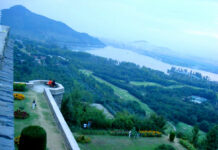Mohammad Ahseem
The two essential sources of water available to humans for drinking and agriculture purposes are surface water and ground water. Surface water resources includes the water that is found on the surface of the earth like rivers, streams, lakes etc. Ground water found below the surface of the earth.
Unlike majority of the geographical regions of the country which are mostly dependent on ground water, replenished by monsoons for both agriculture and human consumption, Kashmir’s geography makes available to people sufficient surface water resources. Majority of these resources are fed by melting of glacial ice in the various mountain ranges surrounding the valley. Except for Jehlum, that has its origin in a spring in south Kashmir, the rivers are fed by snow that is replenished in winters. The agronomy of the valley, besides the drinking needs of the people is seriously tied to these small and major surface water resources.
A cursory holistic look at the water resources of the valley reveals the insensate and apathetic approach adopted by the people in general and authorities in particular. Jhelum, the main river of the valley is subject to very high pollution pressure. In its entire course from south to north of the valley, the river receives limitless amounts of garbage and sewage. The water, once consumed by the locals without any treatment, according to experts has turned poisonous to a high degree. The river has become the abode of used polythene bags and other rubbish which is quite visible to the naked eye.
River Lidder, which has its origin in the Kola Hoi glacier, is a source of irrigation for the orchids spread over a vast area in south Kashmir, besides a number of drinking water schemes being run on its water. The stream provides a serene ambience to the tourist resort of Pahalgam. The river is facing a severe pressure of pollution, due to the unorganised growth of the tourist industry at the famous resort, besides the stress of large number of tourists visiting the place, especially during Yatra period. The amount of threat posed to this river compelled the state High Court to intervene.
Another lively river of the valley that originates from a series of glaciers around Zojila pass, the Sindh is also reported to be polluted due to human activities. The river that passes through the Sonamarg valley of east Kashmir is the lifeline of numerous villages of Ganderbal district. Again the lack of any informed policy, backed by an exercise of Environment Impact Assessment (EIA), for the development of the tourist resort is posing a danger to the milky waters of this stream. The latest instance of insensitivity is the reported case of the army installations having built toilets on its banks. However, this is not any new thing. The twin streams of Lidder at Pahalgam and Sindh at Sonamarg have been receiving the excreta and other refuse of a huge number of Yatris on their way to Amarnath cave shrine.
Fresh Water Rivers and streams, besides their vital role in sustaining the local agronomy and human thirst form the essence of Kashmir as a reemerging tourist destination. A comprehensive policy for the conservation of water resources of the valley, besides specific policies for control and prevention of pollution of individual rivers is the need of the hour. The policy should inculcate the best of international practices and the indigenous modes of water conservation. Above it, the government should promote the age-old practice of Koli-waan( indigenous practice of cleaning of water bodies) by linking it with MGNREGA.









